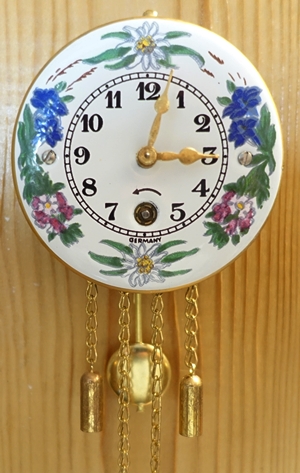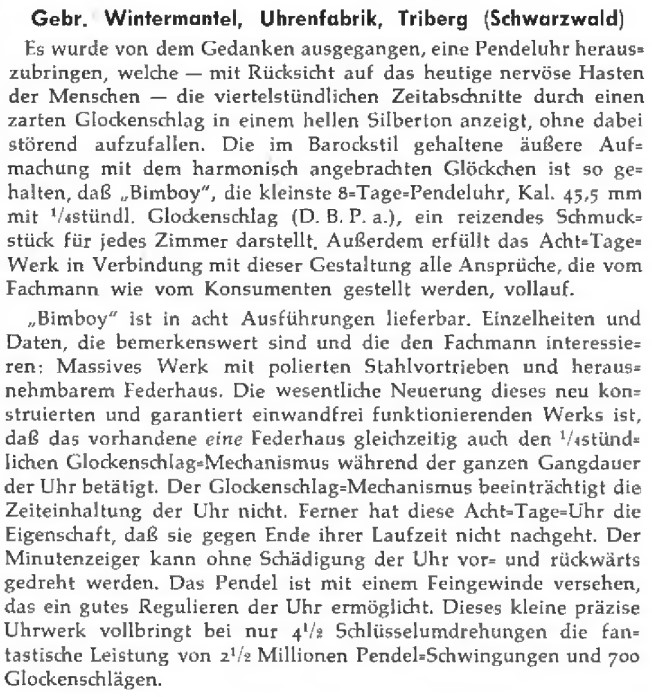Wall clocks are not normally my thing. But the ones shown here are so small and cute that it’s worth taking a closer look at them. These are miniature clocks from the manufacturer Wintermantel in Triberg in the Black Forest, Germany.

The target group for these bric-a-brac clocks were undoubtedly tourists who wanted to take home a little souvenir of the Black Forest.
The Wintermantel company
To avoid any confusion of names, we must first briefly clarify which company Wintermantel from Triberg we are talking about here!
In 1881, Gerson Wintermantel, August Schatz, Joseph Schöpperle, Karl and German Kienzler and Albert Fehrenbach founded the company G. Wintermantel & Co. in Triberg, which was later renamed Schatz & Wintermantel. The company produced small regulators and bric-a-brac clocks.
Gerson Wintermantel also founded his own company in Triberg around 1885, which produced annual clocks. He died in 1914, so the company was probably closed around this time. It certainly still existed in 1910. All the companies mentioned so far with the name Wintermantel have nothing to do with the miniature clocks shown here!

Albert Wintermantel, born in 1882, was a watchmaker and founded his own clock factory in Triberg in 1924. He also made annual clocks, but from around 1927 he specialized in very small 1-day movements with pendulum and spring winding for miniature clocks. This company is the subject of this article.


The company was closed during the First World War. Albert Wintermantel died in 1949 and his sons Otto and Eugen Wintermantel took over the company. Otto was a master watchmaker and became technical manager, his brother Eugen took over the commercial management. They changed the name of the company to Gebr. Wintermantel oHG (Gebr. = Gebrüder = Brothers).

In addition to the 1-day works already mentioned, the company manufactured musical pendulum clocks under the name Winette, as the following advertisement from 1953 shows:

The brand name Winette was later also used for small watches like this:

From 1954, small clocks with an 8-day movement with pendulum and quarter-hour strike on a bell were sold under the brand name Bimboy.

Sometime in the 1970s, the Bimboy brand became the Bimbey brand. This is mentioned in the following advertisement from 1977:

The company produced miniature clocks until Otto Wintermantel’s death in 1979. The company was then to be sold, but the sale to the operations manager of a cuckoo clock factory failed due to lack of funding. The company’s tools finally went to a workshop for people with disabilities run by Caritas Freiburg in 1981. The small movements and clocks are still produced there today and sold under the name Wintermantel. If you are interested, you will find what you are looking for here: https://shop.caritas-freiburg.de/ (search for ‘Wanduhr’ in the search field).
The small watches come nicely packaged in a handy box:


Nice to see that the history of Wintermantel watches continues even after 100 years!
The Wintermantel clock movements
I am showing two Wintermantel movements here:
- A 1-day movement with spring winding and pendulum
- An 8 day movement with spring winding, pendulum and quarter hour strike
There is also a movement by Wintermantel for so-called swing clocks with an up and down regulator instead of a swing pendulum. However, I have not yet come across an example of this movement.
Wintermantel 1-day movement with spring winding and pendulum
The dial of the clock shown at the top has a diameter of only 6 centimeters.

The back of the watch looks like this:

Nothing can be seen of the movement, which is hidden behind a cover cap with the sticker of the seller, Seilnacht Uhren und Schmuck from Freiburg. Which still exists today!
After removing the cover cap, the movement is revealed, which is marked with the name Wintermantel:

In somewhat newer versions of these watches, the rear cover of the movement is made of transparent plastic:

The chains and small weights are purely decorative elements; the movement has a spring winding system, not a weight mechanism!
After pulling off the hands and removing the screws on the dial side, the movement can be removed:


Let’s take a brief look at the technical data of the movement:
- Diameter 45.5 mm
- Inner distance between the two plates: 6.2 mm
- Pin lever escapement
- 0 jewels
- 14,400 bph
Half oscillations of the pendulum per hour, i.e. 4 per second - Power reserve 1 day
- Spring winding
Key: 2.0 mm inside square, corresponds to No. 00 for pocket watch keys - Setting the hands by turning them by hand (possible in both directions)
The movement is cleverly designed. The mainspring barrel can be removed to change the mainspring without having to dismantle the movement. This can also be used to clean the movement without dismantling it.
After removing the plate on the back, the pendulum rod can be taken out and you have a clear view on the movement’s construction:


The pendulum rod is fixed to the pin lever. The power flow in the movement is classic: from the mainspring barrel via the center wheel, the third wheel and the fourth wheel to the escape wheel and then to the pin lever. The movement does not have a seconds display.
The pendulum lens can be moved slightly up or down to adjust the movement. However, this pendulum is not an original from Wintermantel. Their pendulums always had a thread for adjusting the pendulum lens to regulate the movement.
So it’s a nice and simple movement that is sufficient for such a miniature clock, as it is unlikely to be used permanently anywhere as a time display.
The following video shows the small clock in action:
Wintermantel 8-day movement with spring winding, pendulum and quarter-hour strike
This small clock with the inscription BIMBEY measures just 8.8 x 12.0 cm, including the bell:


Technical data of the movement:
- Diameter 45.5 mm
- Inner distance between the two plates: 6 mm + 18 mm for the mainspring barrel
- Pin lever escapement
- 0 jewels
- 10,800 bph
Half oscillations of the pendulum per hour, i.e. 3 per second - Power reserve 8 days
- Quarter-hour strike on bell
Cannot be switched off!
The 8-day movement is also available without the quarter-hour strike. - Spring winding
Key: 2.4 mm inside square - Setting the hands by turning them by hand (possible in both directions)
Naturally, the movement requires a significantly larger barrel than the 1-day movement due to the longer running time. The quarter-hour strike strikes the bell once every quarter of an hour, so the number of strikes does not vary and the number of hours is not struck either!
Let’s take a look at the movement:

Notice the two extra bridges, one for the large barrel and one for the hammer of the bell. The pendulum rod is bent to find a way around the barrel.
The pendulum rod is significantly longer than on the 1-day movement and has a thread for adjusting the pendulum lens to regulate the movement.

This is what the movement looks like from the side:

In contrast to the 1-day movement, the mainspring barrel does not drive the center wheel here, but rather the large intermediate wheel visible in the picture. This provides the correct transmission ratio for the 8-day power reserve and causes this movement to oscillate somewhat more slowly than the 1-day movement. The intermediate wheel then drives the minute wheel.
Let’s take a look at how the chime works:

There are four metal pins on the minute wheel in the center of the movement, i.e. one for every quarter of an hour. Two of them are marked in red in the following picture:

The lateral extension of the bell’s hammer engages at this point.

This slides along one of the pins for a quarter of an hour at a time, tensioning the hammer spring. At the end of the quarter of an hour, it falls out of engagement with the pin and the hammer falls against the bell.

Hi Andreas, thank you for the article, that was nice to learn about the history etc, I am a bit confused as I have an almost identical miniature clock with a very similar ceramic floral face, but the name inside is J Engstler, made in Germany, can you throw any light on this and the connection if any.
Hi Stewart,
I know of a Josef Engstler from Villingen in Germany. The company was founded in 1952 and is still in business today:
Today they manufacture Black Forest clocks, but I don’t know if they also created miniature clocks, or used Wintermantel movements.